Success of Social Media Marketing Efforts in Retaining Sustainable Online Consumers: An Empirical Analysis on the Online Fashion Retail Market
Abstract
1. Introduction
2. Literature Review
2.1. Social Media Marketing and Its Five Measures
2.2. Social Media Marketing and Brand Loyalty
2.3. Social Media Marketing and Brand Preference
2.4. Social Media Marketing and Brand Association
2.5. Social Media Marketing and Brand Attachment
2.6. Social Media Marketing and Buying Commitment
3. Hypothesis Development
4. Methodology
4.1. Data Sampling
4.2. Descriptive Data
4.3. Validity Measure
5. Analysis of Results
5.1. Measurement Instrument and Chi-Square Test
5.2. Hypotheses Testing
5.3. Summary of Hypotheses Testing
6. Discussion of Results
7. Conclusions
7.1. Managerial Implications
7.2. Practical Implications
7.3. Limitation and Future Research Scope
Author Contributions
Funding
Acknowledgments
Conflicts of Interest
References
- Albors, J.; Ramos, J.C.; Hervas, J.L. New learning network paradigm: Communities of objectives, croudsourcing, wikis and open source. Int. J. Inf. Manag. 2008, 28, 194–202. [Google Scholar] [CrossRef]
- Lamberton, C.; Stephen, A.T. A thematic exploration of digital, social media and mebile marketing. J. Mark. 2016, 80, 146–172. [Google Scholar] [CrossRef]
- Kang, Y.M.; Park, B. Sustainable Corporate Social Media Marketing Based on Message Structural Features: Firm Size Plays a Significant Role as a Moderator. Sustainability 2018, 10, 1167. [Google Scholar] [CrossRef]
- Eric, W.T.N.; Karen, K.L.M.; Tao, S.C. Social media research: Theories, constructs, and conceptual frameworks. Int. J. Inf. Manag. 2015, 35, 33–44. [Google Scholar]
- Kim, A.J.; Ko, E. Impact of luxury fashion brand’s social media marketing of customer relationship and purchase intension. J. Glob. Fash. Mark. 2010, 1, 164–171. [Google Scholar] [CrossRef]
- Netemeyer, R.G.; Balaji, C.K.; Pullig, C.; Wirth, F. Developing and validating measures of facets of customer-based brand equity. J. Bus. Res. 2004, 57, 209–224. [Google Scholar] [CrossRef]
- Martin, K.; Todorov, I. How will digital platforms be harnessed in 2010, and how will they change the way people interact with brands? J. Advert. 2010, 10, 61–66. [Google Scholar] [CrossRef]
- Muntinga, D.G.; Moorman, M.; Smit, E.G. Introducing COBRAS: Exploring motivations for brand elated social media use. Int. J. Advert. 2011, 30, 13–46. [Google Scholar] [CrossRef]
- Bennett, R.; Rundle-Thiele, S. A Comparison of Attitudinal Loyalty Measurement Approaches. J. Brand Manag. 2002, 9, 193–209. [Google Scholar] [CrossRef]
- Chaudhuri, A.; Holbrook, M.B. The Chain of Effects from Brand Trust and Brand Affect to Brand Performance: The Role of Brand Loyalty. J. Mark. 2001, 65, 81–93. [Google Scholar] [CrossRef]
- Isik, A.; Yasar, M.F. Effects of brand on consumer preferences: A study in Turkmenistan. Eur. J. Bus. Econ. 2015, 8, 139–150. [Google Scholar] [CrossRef]
- Chattopadhyay, A.; Alba, J.W. The situational importance of recall and inference in consumer decision making. J. Consum. Res. 1988, 15, 1–12. [Google Scholar] [CrossRef]
- Laroche, M.; Habibi, M.R.; Richard, M.O. To be or not to be in social media: How brand loyalty is affected by social media. Int. J. Inf. Manag. 2015, 33, 76–82. [Google Scholar] [CrossRef]
- Laroche, M.; Habibi, M.R.; Richard, M.O.; Sankaranarayanan, R. Effects of social media based brand communities on brand community markers, value cration practice, brand trust and brand loyalty. Comput. Hum. Behav. 2013, 28, 1755–1767. [Google Scholar] [CrossRef]
- Kim, A.J.; Ko, E. Do social media marketing activity enhance customer equity? An empirical study on luxury fashion brand. J. Bus. Res. 2016, 65, 1480–1486. [Google Scholar] [CrossRef]
- Phan, M.; Thomas, R.; Heine, K. Social Media and Luxury Brand Management: The case of Burberry. J. Glob. Fash. Mark. 2011, 2, 213–222. [Google Scholar] [CrossRef]
- Kaplan, A.M.; Haenlein, M. Users of the world, unite! The challenges and opportunities of social media. Bus. Horiz. 2010, 53, 59–68. [Google Scholar] [CrossRef]
- Hennig-Thurau, T.; Hofacker, C.F.; Bloching, B. Marketing the pinball way: Understanding how the social media change the generation of value for the consumers and companies. J. Interact. Mark. 2013, 27, 237–241. [Google Scholar] [CrossRef]
- Verma, R.; Stock, D.; McCarthy, L. Customer Preferences for online, social media and mobile innovations in the hospitality industry. Cornell Hosp. Q. 2012, 53, 183–186. [Google Scholar] [CrossRef]
- Agichtein, E.; Castillo, C.; Donato, D.; Aristides, G.; Gilad, M. Finding High Quality Content in Social Media. In Proceedings of the 2008 International Conference on Web Search and Data Mining, Palo Alto, CA, USA, 11–12 February 2008; pp. 183–193. [Google Scholar]
- Manthiou, A.; Chiang, L.; Tang, L. Identifying and responding to customer needs on Facebook fan pages. Int. J. Technol. Hum. Interact. 2013, 9, 36–52. [Google Scholar] [CrossRef]
- Godey, B.; Manthiou, A.; Pederzoli, D.; Rokka, J.; Aiello, G.; Donvito, R.; Singh, R. Social media marketing effort of luxury brands: Influence on brand equity and consumer behavior. J. Bus. Res. 2016, 69, 5833–5841. [Google Scholar] [CrossRef]
- Naaman, M.; Becker, H.; Gravano, L. Hip and trendy: Characterizing emerging trends on twitter. J. Am. Soc. Inf. Sci. Technol. 2011, 62, 902–918. [Google Scholar] [CrossRef]
- Schmenner, R.W. How can service business survive and prosper. Sloan Manag. Rev. 1986, 27, 21–32. [Google Scholar]
- Zhu, Y.Q.; Chen, H.G. Social media and human need satisfaction: Implications for social media marketing. Bus. Horiz. 2015, 58, 335–345. [Google Scholar] [CrossRef]
- Park, J.H.; Lee, J. E-WOM overload and its behavioural effect on consumer intension depends on consumer’s involvement. Electron. Commer. Res. Appl. 2008, 7, 386–398. [Google Scholar] [CrossRef]
- Erdem, T.; Swait, J.; Valenzuela, A. Brands as signals, cross country validation study. J. Mark. 2006, 70, 34–49. [Google Scholar] [CrossRef]
- Dellarocus, C. The digitization of word of mouth: Promise and challenges of online feedback and machanisms. Manag. Sci. 2003, 49, 1407–1424. [Google Scholar] [CrossRef]
- Cheung, C.M.K.; Lee, M.K.O.; Rabjhan, N. The impact of electronic Word of Mouth:the adoption of online opinions in online customer communities. Internet Res. 2008, 18, 229–247. [Google Scholar] [CrossRef]
- Willemsen, L.M.; Niejens, P.C.; Bronner, F.; De Ridder, J.A. Highly recommended! The content characteristics and perceived usefulness of online consumer reviews. J. Comput.-Mediat. Commun. 2011, 17, 19–38. [Google Scholar] [CrossRef]
- Filieri, R. What makes online reviews helpful? A diagonisticity-adoption framework to explain informational and normative influence of E-WOM. J. Bus. Res. 2015, 68, 1261–1270. [Google Scholar] [CrossRef]
- Gallaugher, J.; Ransbotham, S. Social media and customer dialogue management at starbucks. MIS Q. Exec. 2010, 9, 197–212. [Google Scholar]
- Dougherty, T.; Eastin, M.S.; Bright, L. Exploring consumer motivations for creating user generated content. J. Interact. Advert. 2013, 8, 16–25. [Google Scholar] [CrossRef]
- Meltzer, M.; Stefanescu, L.; Ozunu, A. Keep them Engaged: Romanian County inpectoraes for emergency situations’ Facebook Usage for Disaster Risk Communications and beyond. Sustainability 2018, 10, 1411. [Google Scholar] [CrossRef]
- Kim, J.; Lee, K.H. Influence of integration on interactivity in social media luxury brand communities. J. Bus. Res. 2019, 99, 422–429. [Google Scholar] [CrossRef]
- VanMeter, R.; Syrdal, H.A.; Powell-Mantel, S.; Grisaffe, D.B.; Nesson, E.T. Don’t Just “Like” Me, Promote Me: How Attachment and Attitude Influence Brand Related Behaviors on Social Media. J. Interact. Mark. 2018, 43, 83–97. [Google Scholar] [CrossRef]
- Yoshida, M.; Gordon, B.S.; Nakazawa, M.; Shibuya, S.; Fujiwara, N. Bridging the gap between social media and behavioural brand loyalty. Electron. Commer. Res. Appl. 2018, 28, 208–218. [Google Scholar] [CrossRef]
- Chen, S.C.; Lin, C.P. Understanding the effects of social media marketing activities: The mediation of social identification, perceived value and satisfaction. Technol. Forecast. Soc. 2019, 140, 22–31. [Google Scholar] [CrossRef]
- Felix, R.; Philipp, A.R.; Hinsch, C. Elements of strategic social media marketing: A holistic framework. J. Bus. Res. 2017, 70, 118–126. [Google Scholar] [CrossRef]
- Nisar, T.M.; Whitehead, C. Brand interactions and social media: Enhancing user loyalty through social networking sites. Comput. Hum. Behav. 2016, 62, 743–753. [Google Scholar] [CrossRef]
- Yan, Q.; Wu, S.; Wang, L.; Wu, P.; Chen, H.; Wei, G. E-WOM from e-commerce websites and social media: Which will consumers adopt? Electron. Commer. Res. Appl. 2016, 17, 62–73. [Google Scholar] [CrossRef]
- Hajli, N. Social commerce constructs and consumer’s intention to buy. Int. J. Inf. Manag. 2015, 35, 183–191. [Google Scholar] [CrossRef]
- Davis, R.; Piven, I.; Breazeale, M. Conceptualizing the brand in social media community: The five sources model. J. Retail. Consum. Serv. 2004, 21, 468–481. [Google Scholar] [CrossRef]
- Fournier, S.; Avery, J. The uninvited brand. Bus. Horiz. 2011, 54, 193–207. [Google Scholar] [CrossRef]
- Srinivasan, S.S.; Anderson, R.; Ponnavolu, K. Customer loyalty in e-commerce: An exploration of its antecedents and consequences. J. Retail. 2004, 78, 41–50. [Google Scholar] [CrossRef]
- McAlexander, J.H.; Schouten, J.W.; Koenig, H.F. Building brand community. J. Mark. 2002, 66, 38–45. [Google Scholar] [CrossRef]
- Casaló, L.V.; Flavián, C.; Guinalíu, M. Relationship quality, community promotion and brand loyalty in virtual communities: Evidence from free software communities. Int. J. Inf. Manag. 2010, 30, 357–367. [Google Scholar] [CrossRef]
- Brodie, R.J.; Ilic, A.; Juric, B.; Hollebeek, L. Consumer engagement in a virtual brand community: An exploratory analysis. J. Bus. Res. 2013, 66, 105–114. [Google Scholar] [CrossRef]
- Algesheimer, R.; Dholakia, U.M.; Herrmann, A. The social influence of brand community: Evidence from European car clubs. J. Mark. 2005, 69, 19–34. [Google Scholar] [CrossRef]
- Bagozzi, R.P.; Dholakia, U.M. Intentional social action in virtual communities. J. Interact. Mark. 2002, 16, 2–21. [Google Scholar] [CrossRef]
- Habibi, M.R.; Laroche, M.; Richard, M.O. The roles of brand community and community engagement in building brand trust on social media. Comput. Hum. Behav. 2014, 37, 152–161. [Google Scholar] [CrossRef]
- Labrecque, L.I. Fostering consumer-brand relationships in social media environments: The role of para-social interaction. J. Interact. Mark. 2014, 28, 134–148. [Google Scholar] [CrossRef]
- Ku, Y.; Chen, R.; Zhang, H. Why do users continue using social networking sites? An exploratory study of members in the United States and Taiwan. Inf. Manag. 2013, 50, 571–581. [Google Scholar] [CrossRef]
- Ryan, D.; Jones, C. Digital Marketing Strategies for Engaging the Digital Generation; Kogan Page Limited: London, UK, 2009. [Google Scholar]
- Krasnova, H.; Spiekermann, S.; Koroleva, K.; Hildebrand, T. Online social networks: Why we disclose. J. Inf. Technol. 2010, 25, 109–125. [Google Scholar] [CrossRef]
- Lim, J.; Hwang, Y.; Kim, S.; Biocca, F. How social media engagement leads to sports channel loyalty: Mediating roles of social presence and channel commitment. Comput. Hum. Behav. 2015, 46, 158–167. [Google Scholar] [CrossRef]
- Luo, N.; Zhang, M.; Liu, W. The effects of value co-creation practices on building harmonious brand community and achieving brand loyalty on social media in China. Comput. Hum. Behav. 2015, 48, 492–499. [Google Scholar] [CrossRef]
- Mohammadi, H. A study of mobile banking loyalty in Iran. Comput. Hum. Behav. 2015, 44, 35–47. [Google Scholar] [CrossRef]
- Grubb, E.L.; Grathwohl, H.L. Consumer self-concept, symbolism, and market behaviour: A theoretical approach. J. Mark. 1967, 31, 22–27. [Google Scholar] [CrossRef]
- Muniz, A.M.; O’Guinn, T.C. Brand community. J. Consum. Res. 2001, 27, 412–433. [Google Scholar] [CrossRef]
- Park, H.; Kim, Y.K. The role of social network websites in the consumer-brand relationship. J. Retail. Consum. Serv. 2014, 21, 460–467. [Google Scholar] [CrossRef]
- Jamal, A.; Goode, M. Consumers and brands: A study of the impact of selfImage congruence on brand preference and satisfaction. Mark. Intell. Plan. 2001, 19, 482–492. [Google Scholar] [CrossRef]
- Tokunaga, R.S. Social networking site or social surveillance sites under- standing the use of interpersonal electronic surveillance in romantic relation- ships. Comput. Hum. Behav. 2011, 27, 705–713. [Google Scholar] [CrossRef]
- Valenzuela, S.; Park, N.; Kee, K.F. Is there social capital in a social network site? Facebook use and college students’ life satisfaction, trust, and Participation. J. Comput.-Mediat. Commun. 2009, 14, 875–901. [Google Scholar] [CrossRef]
- Hollenbaugh, E.E.; Ferris, A.L. Facebook self-disclosure: Examining the role of traits, social cohesion, and motives. Comput. Hum. Behav. 2014, 30, 50–58. [Google Scholar] [CrossRef]
- Park, N.; Kee, K.F.; Valenzuela, S. Being immersed in social networking environment: Facebook groups, uses and gratifications, and social outcomes. Cyberpsychol. Behav. 2009, 12, 729–733. [Google Scholar] [CrossRef] [PubMed]
- Steinfield, C.; Ellison, N.B.; Lampe, C. Social capital, self-esteem, and use of online social network sites: A longitudinal analysis. J. Appl. Dev. Psychol. 2008, 29, 434–445. [Google Scholar] [CrossRef]
- Normann, R. Service Management: Strategy and Leadership in Service Business; John Wiley & Sons: Hoboken, NJ, USA, 1991. [Google Scholar]
- Porter, S.S.; Claycomb, C. The influence of brand recognition on retail store image. J. Prod. Brand Manag. 1997, 6, 373–384. [Google Scholar] [CrossRef]
- Park, W.C.; Deborah, J.M.; Priester, J.; Andreas, B.E.; Iacobucci, D. Brand Attachment and Brand Attitude Strength: Conceptual and Empirical Differentiation of Two Critical Brand Equity Drivers. J. Mark. 2010, 74, 1–17. [Google Scholar] [CrossRef]
- Bowlby, J. Attachment and Loss: Attachment; Basic Books: New York, NY, USA, 1980. [Google Scholar]
- Riemer, K.; Lehrke, C. Biased listing in electronic marketplaces: Exploring its implications in on-line hotel distribution. Int. J. Electron. Commun. 2009, 14, 55–78. [Google Scholar] [CrossRef]
- Senecal, S.; Nantel, J. The influence of online product recommendation on consumers’ online choices. J. Retail. 2004, 80, 159–169. [Google Scholar] [CrossRef]
- Yubo, C.; Jinhong, X. Third-party product review and firm marketing strategy. J. Mark. Sci. 2005, 24, 218–240. [Google Scholar]
- Chris, F.; Anindya, G.; Batia, W. Examining the relationship between reviews and sales: The role of reviewer identity disclosure in electronic markets. Inf. Syst. Res. 2008, 19, 291–313. [Google Scholar]
- Reyes-Menendez, A.; Palos-Sanchez, P.R.; Saura, J.R.; Martin-Velicia, F. Understanding the Influence of Wireless Communications and Wi-Fi Access on Customer Loyalty: A Behavioral Model System. Wirel. Commun. Mob. Comput. 2018, 2018. [Google Scholar] [CrossRef]
- Khan, M.A.; Mahmood, Z. Impact of brand loyalty factors on brand equity. Int. J. Acad. Res. 2012, 4, 33–38. [Google Scholar]
- Gounaris, S.; Stathakopoulos, V. Antecedents and consequences of brand loyalty: An empirical study. J. Brand Manag. 2004, 11, 283–306. [Google Scholar] [CrossRef]
- Kabiraj, S.; Shanmugan, J. Development of a conceptual framework for brand loyalty: A Euro-Mediterranean Perspective. J. Brand Manag. 2011, 18, 285–299. [Google Scholar] [CrossRef]
- Harmeling, C.; Moffett, J.W.; Arnold, M.J.; Carlson, B.D. Toward a theory of customer engagement marketing. J. Acad. Mark. Sci. 2017, 45, 312–335. [Google Scholar] [CrossRef]
- Pansari, A.; Kumar, V. Customer engagement: The construct, antecedents, and consequences. J. Acad. Mark. Sci. 2017, 45, 294–311. [Google Scholar] [CrossRef]
- Van Doorn, J.; Lemon, K.N.; Mittal, V.; Nass, S.; Pick, D.; Pirner, P.; Verhoef, P.C. Customer engagement behaviour: Theoretical foundations and research directions. J. Serv. Res. 2010, 13, 253–266. [Google Scholar] [CrossRef]
- Belen Del Rio, A.; Vazquezm, R.; Iglesias, V. The effects of brand associations on consumer response. J. Consum. Mark. 2001, 18, 410–425. [Google Scholar] [CrossRef]
- Keller, K.L. Conceptualizing, measuring and managing customer equity. J. Mark. 1993, 57, 1–22. [Google Scholar] [CrossRef]
- Kleijnen, M.K.; De Ruyter, K.; Andreassen, T.W. Image Congruence and the adoption of service innovations. J. Serv. Res. 2005, 7, 343–359. [Google Scholar] [CrossRef]
- Mehta, A. Using self-concept to assess advertising effectiveness. J. Advert. Res. 1999, 39, 81–89. [Google Scholar]
- Kumar, V.; Aksoy, L.; Donkers, B.; Venkatesan, R.; Wiesel, T.; Tillmanns, S. Undervalued or overvalued customers: Capturing total customer engagement value. J. Serv. Res. 2010, 13, 297–310. [Google Scholar] [CrossRef]
- Bowden, J.L.H. The process of customer engagement: A conceptual framework. J. Mark. Theory Pract. 2009, 17, 63–74. [Google Scholar] [CrossRef]
- Kozinets, R.V.; De Vlack, K.; Woznicki, A.C.; Wilner, S. Network Narratives: Understanding Word-of Mouth marketing in online communities. J. Mark. 2010, 74, 71–89. [Google Scholar] [CrossRef]
- Shultz, D.E. IMC measurement: The challenges of interactive marketplace. Int. J. Mark. Commun. 2011, 3, 7–24. [Google Scholar]
- Shultz, D.E.; Paltier, J. Social media’s slippery slope, challenges opportunities and future directions. J. Interact. Mark. 2013, 7, 86–99. [Google Scholar] [CrossRef]
- Keller, K.L.; Lehmann, D.R. Brands and Branding: Research findings and future priorities. Mark. Sci. 2006, 25, 740–759. [Google Scholar] [CrossRef]
- Lessar, W.; Mittal, B.; Sharma, A. Measuring Customer Based Brand Equity. J. Consum. Mark. 1995, 12, 11–19. [Google Scholar] [CrossRef]
- Cobb-Walgren, C.J.; Ruble, C.A.; Donthu, N. Brand Equity, Brand Preference, and Purchase Intent. J. Advert. 1995, 24, 25–40. [Google Scholar] [CrossRef]
- Palos-Sanchez, P.R.; Saura, J.R. The Effect of Internet Searches on Afforestation: The Case of a Green Search Engine. Forests 2018, 9, 51. [Google Scholar] [CrossRef]
- Palos-Sanchez, P.; Saura, J.R.; Martin-Velicia, F. A study of the effects of programmatic advertising on users’ concerns about privacy overtime. J. Bus. Res. 2019, 96, 61–72. [Google Scholar] [CrossRef]
- Bilgihan, A.; Bujisik, M. The Effect of Website Features in Online Relationship Marketing: A Case of Online Hotel Booking. Electron. Commer. Res. Appl. 2015, 14, 222–232. [Google Scholar] [CrossRef]
- Confos, N.; Davis, T. Young consumer-brand relationship building potential using digital marketing. Eur. J. Mark. 2016, 50, 1993–2017. [Google Scholar] [CrossRef]
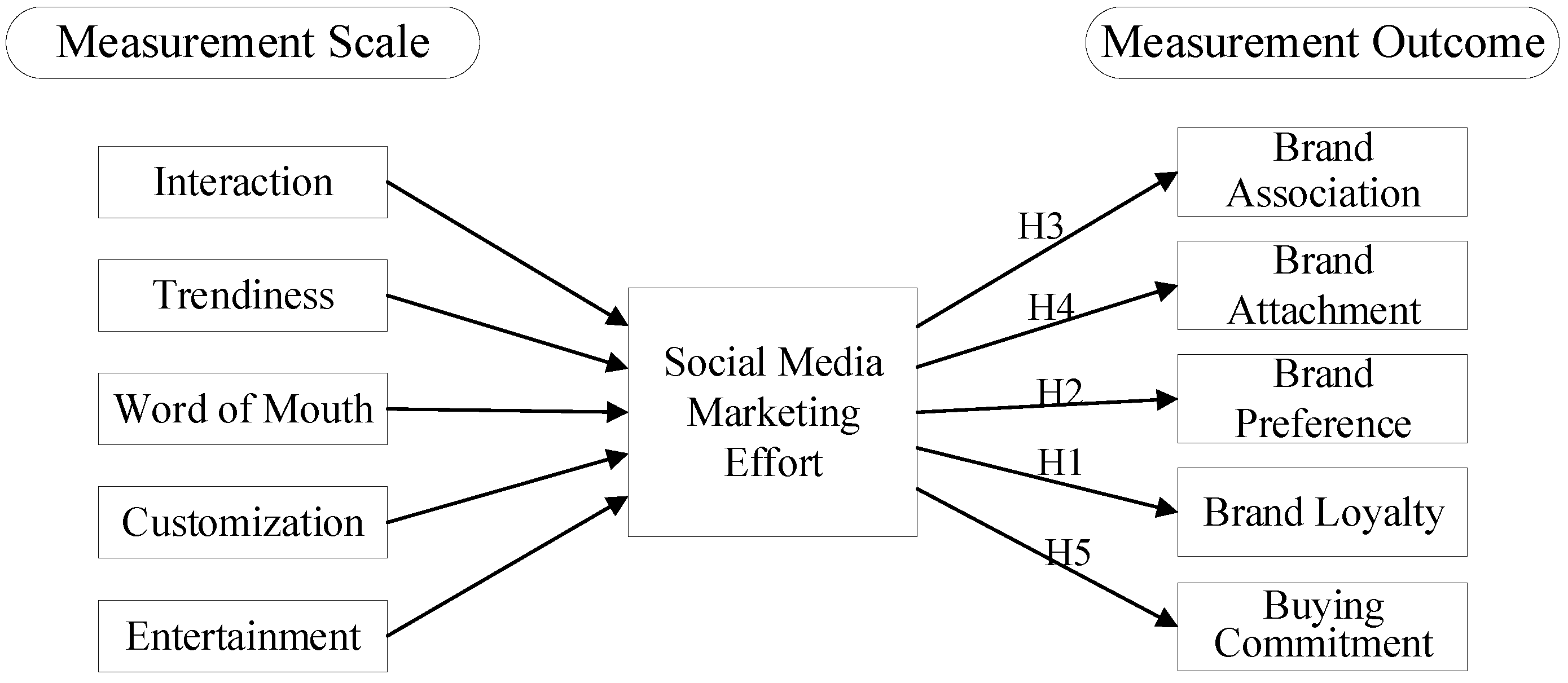

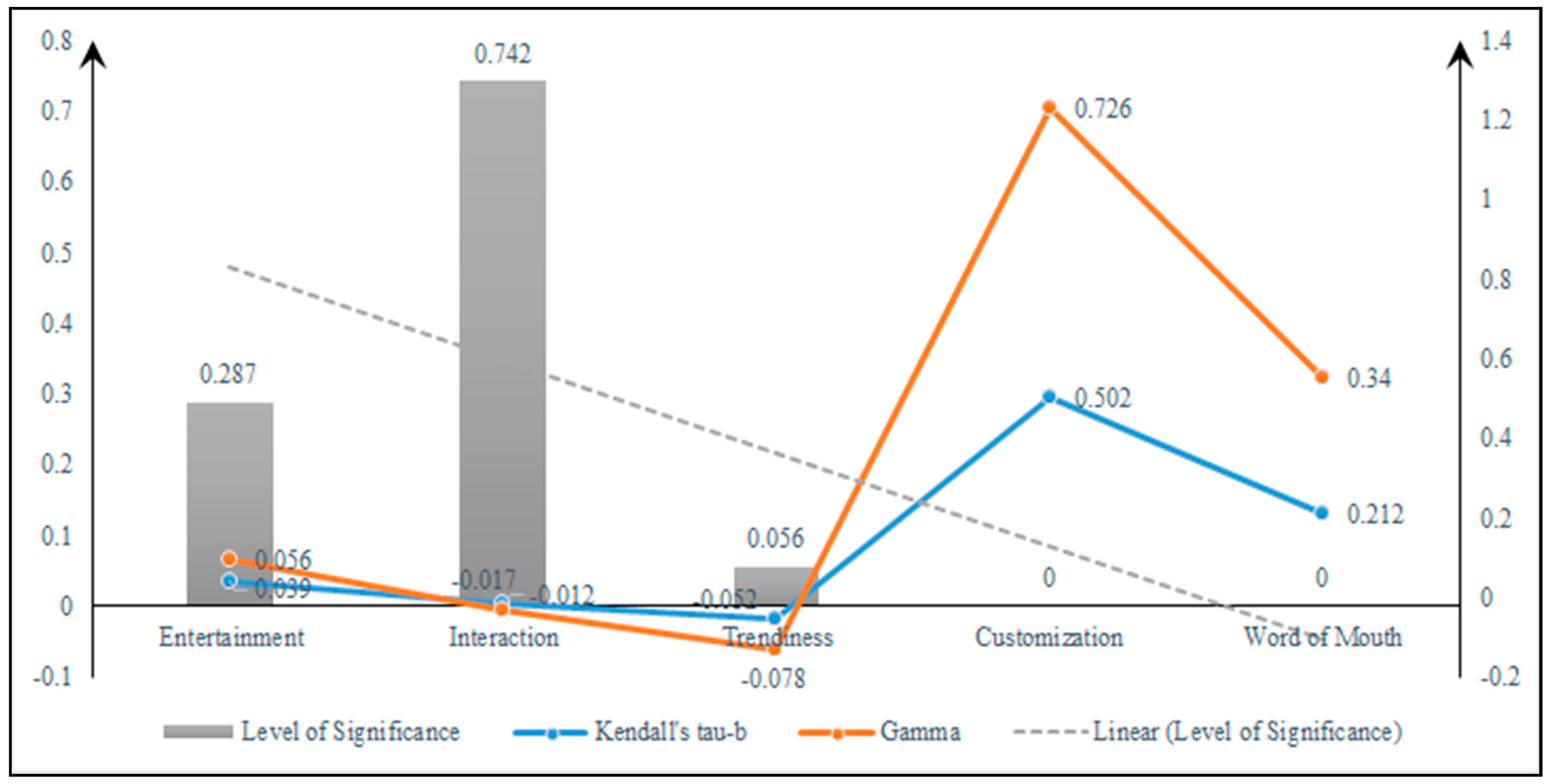
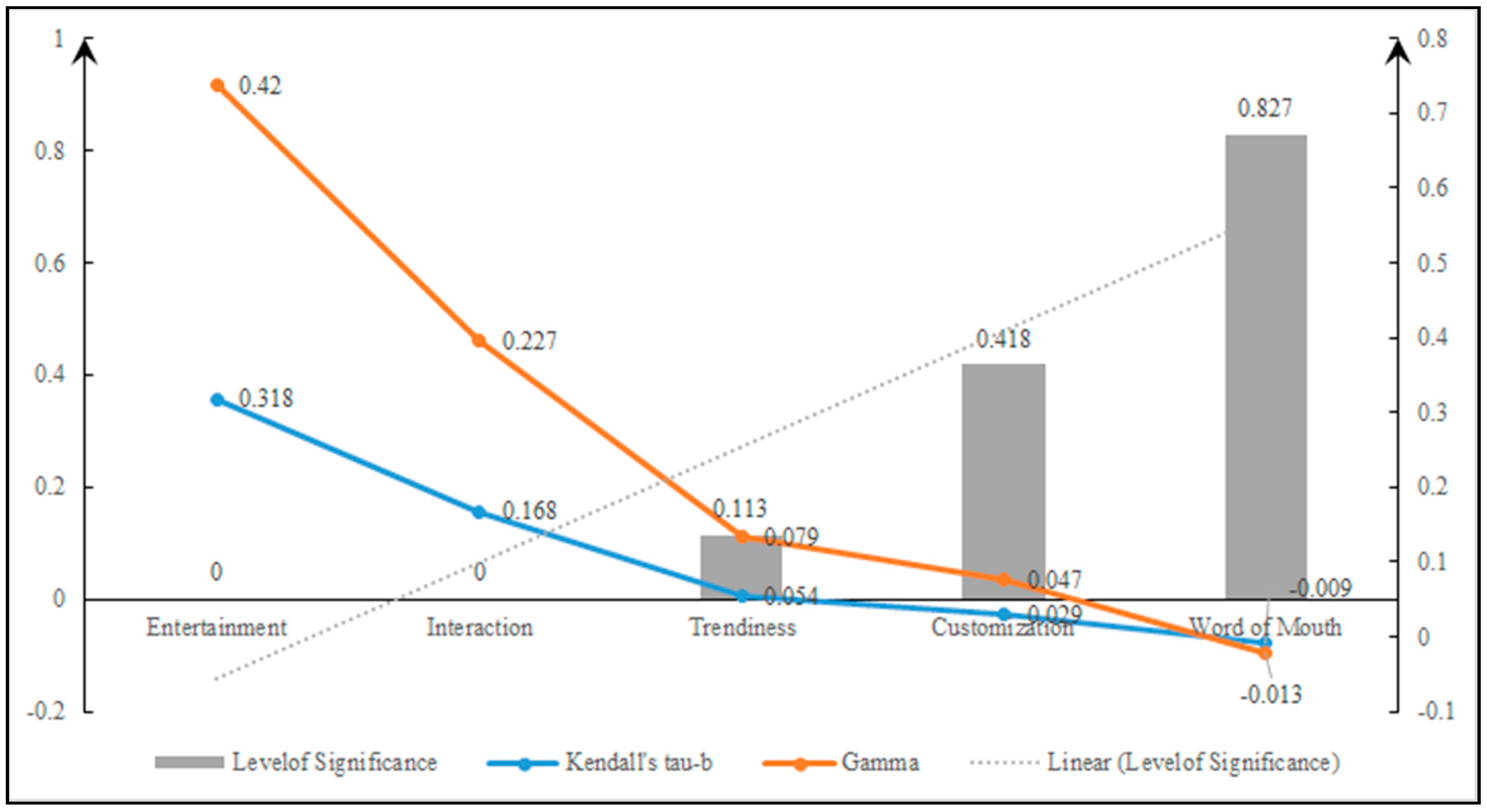
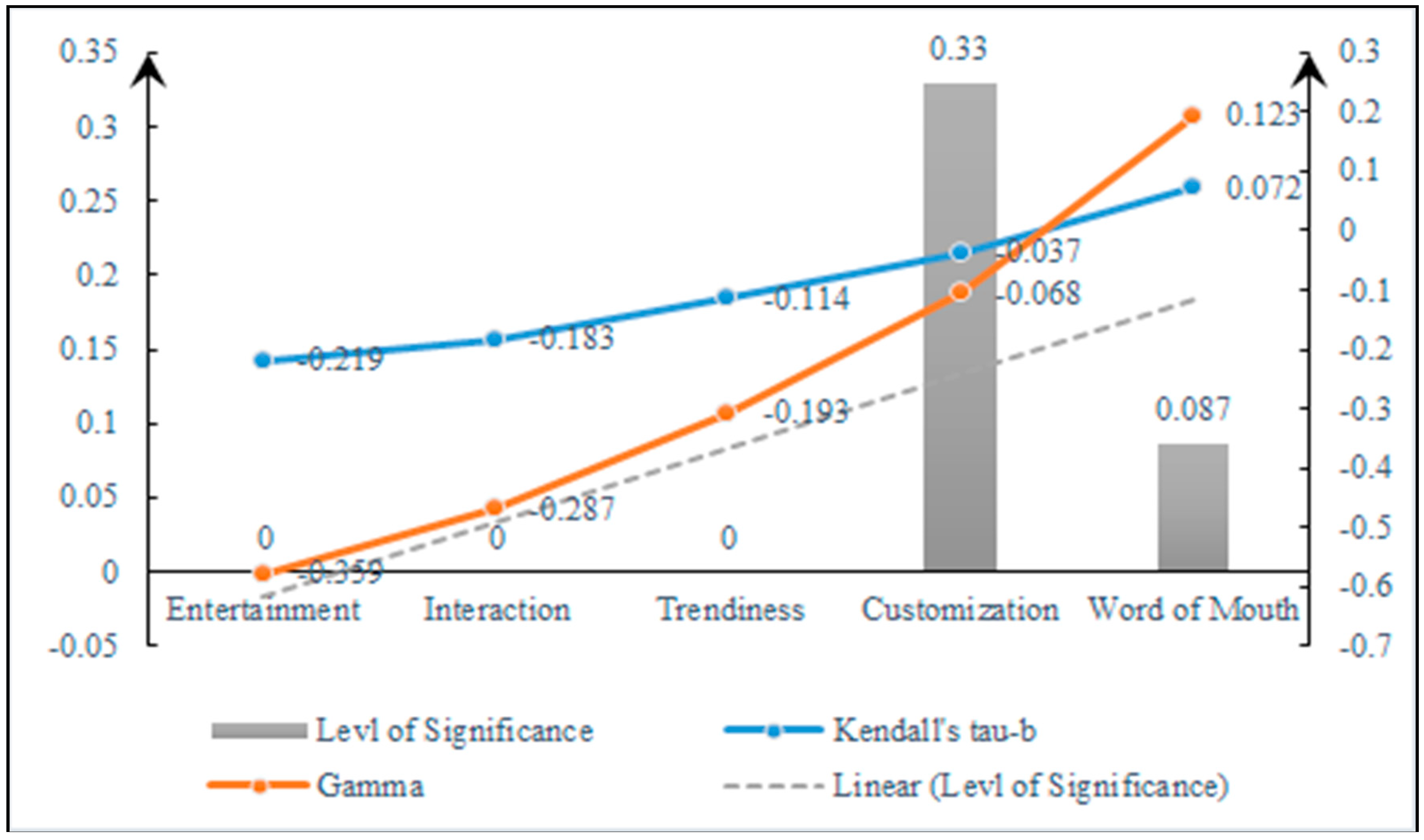

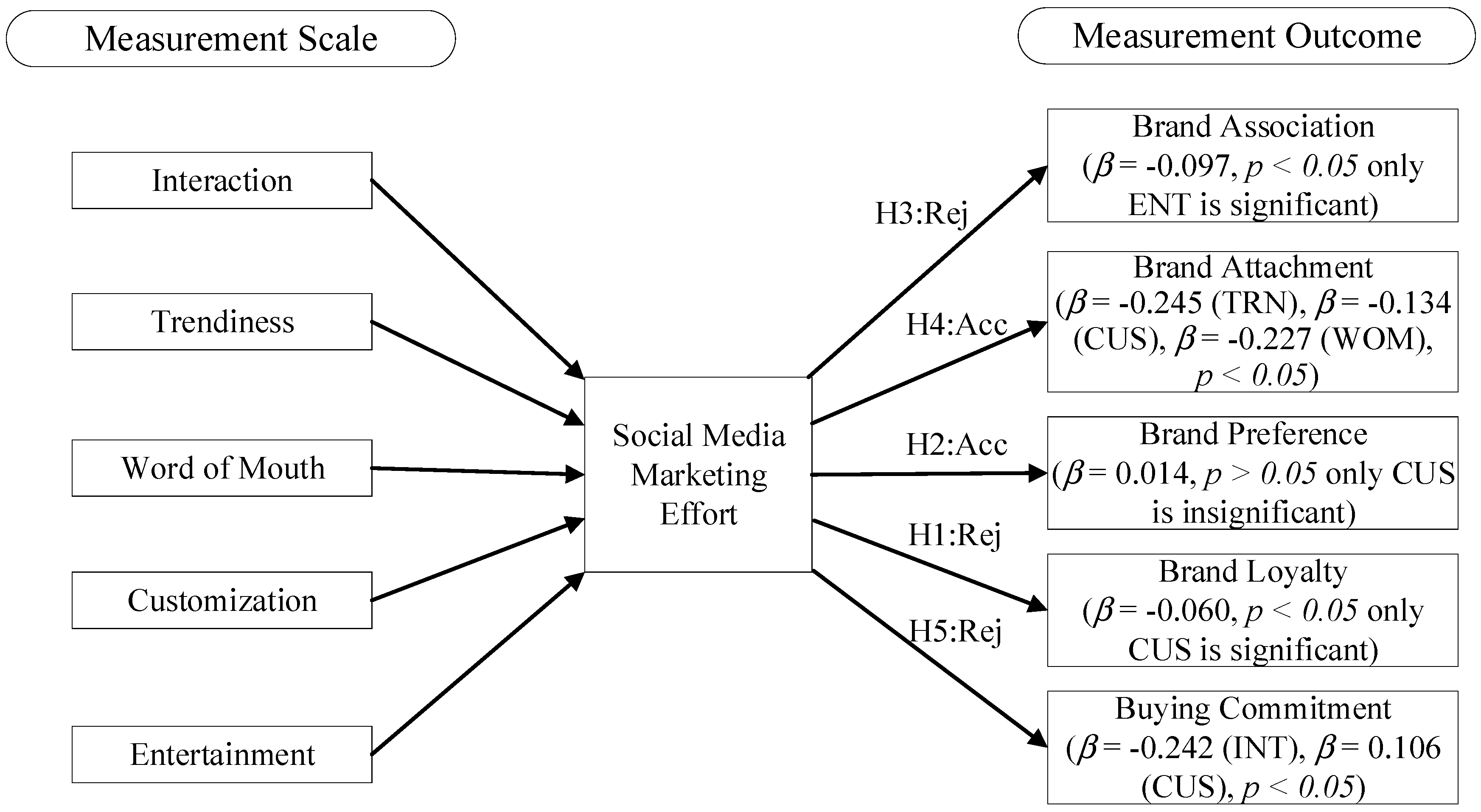
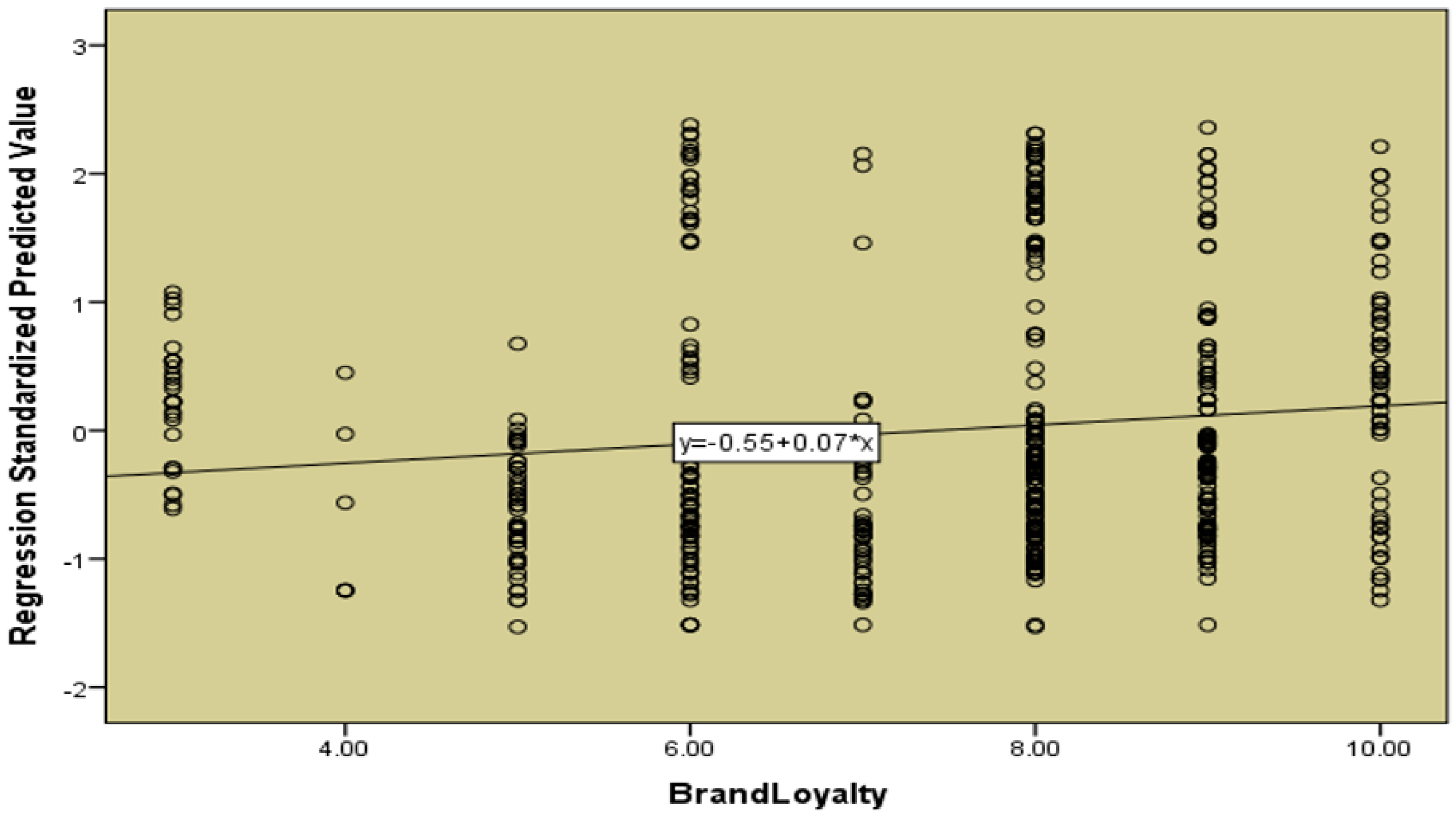
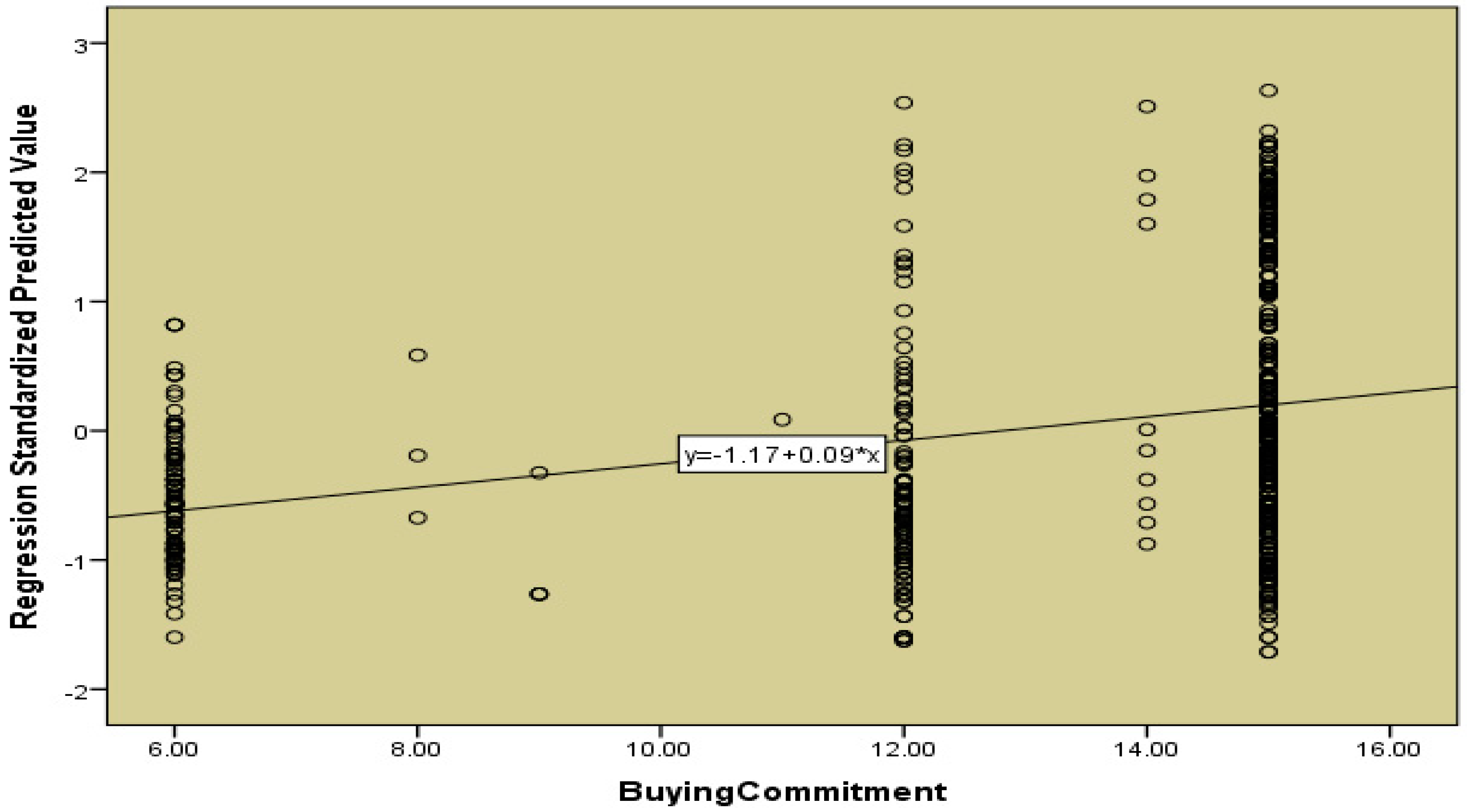
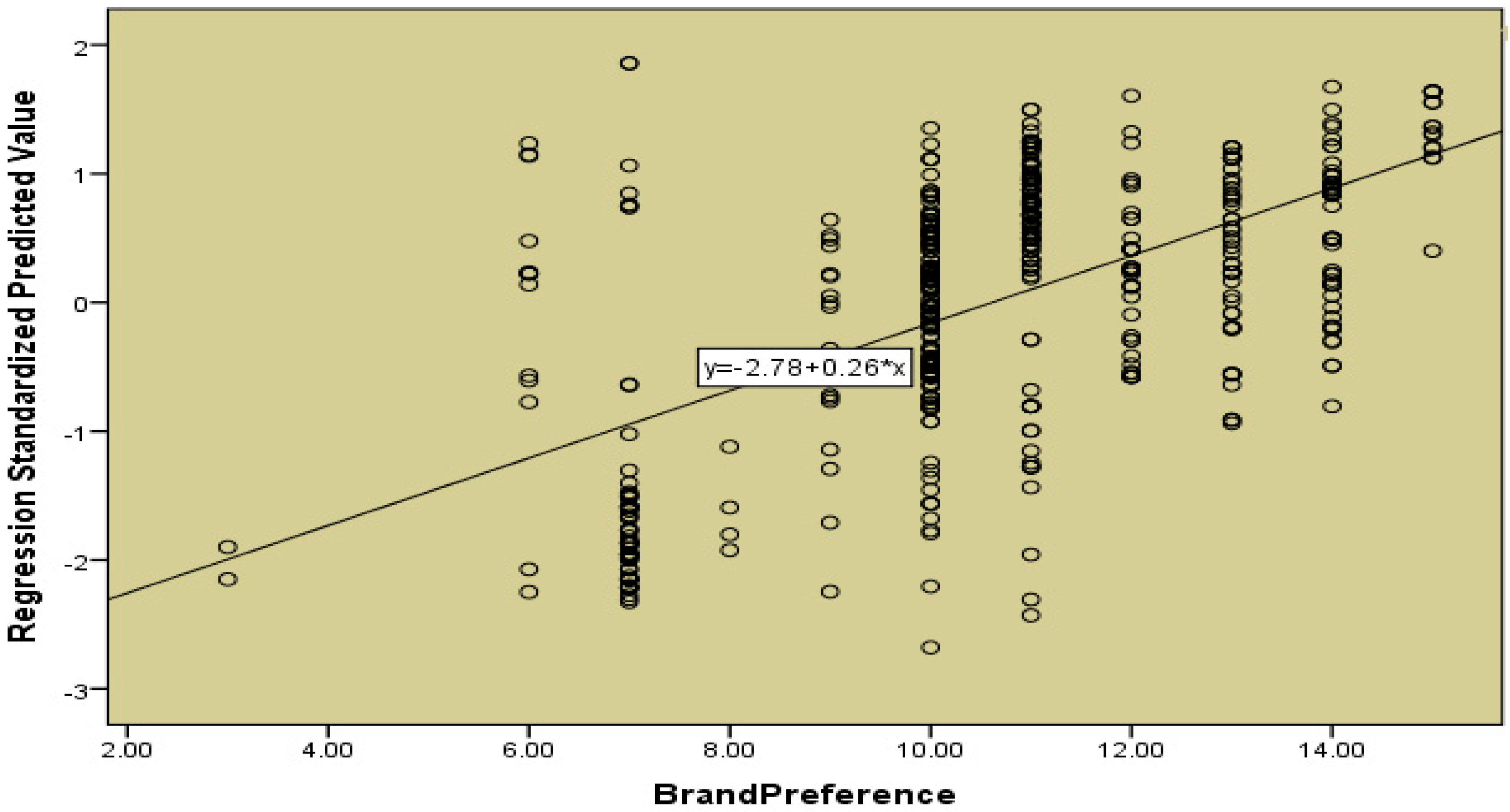

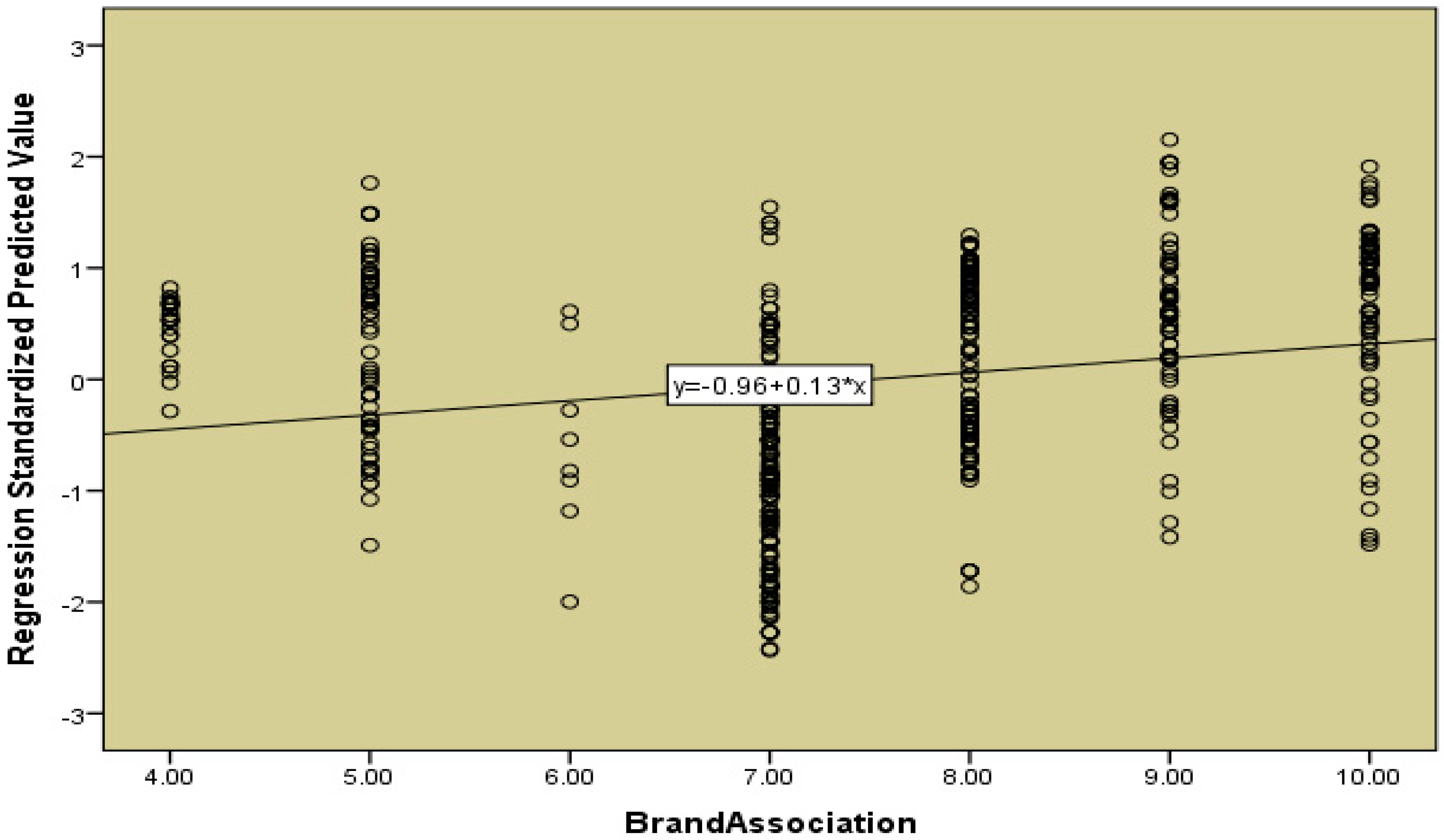
| Author | Year | Research |
|---|---|---|
| Kim and Lee [35] | 2019 | Influence of Integration on Interactivity in Social Media Luxury Brand Communities |
| Venmeter et al. [36] | 2018 | Don’t Just “Like” Me, Promote Me: How Attachment and Attitude Influence Brand Related Behaviors on Social Media |
| Yoshida et al. [37] | 2018 | Bridging the Gap between Social Media and Behavioral Brand Loyalty |
| Chen and Lin [38] | 2019 | Understanding the effect of social media marketing activities: the mediation of social identification, perceived value and satisfaction. |
| Felix et al. [39] | 2017 | Elements of Strategic Social Media Marketing: A Holistic Framework |
| Godey et al. [22] | 2016 | Social Media Marketing Efforts of Luxury Brands: Influence on Brand Equity and Consumer Behavior |
| Nisar and Whitehead [40] | 2016 | Brand Interactions and Social Media, Enhancing User Loyalty through Social Media Sites |
| Yan et al. [41] | 2015 | E-WOM from E-Commerce Websites and Social Media: Which Will Consumers Adopt? |
| Hajli [42] | 2015 | Social Commerce Constructs and Consumer’s Intention to Buy |
| Eric et al. [4] | 2015 | Social Media Research: Theories, Constructs, and Conceptual Frameworks |
| Kim and Ko [15] | 2012 | Do Social Media Marketing Activities Enhance Customer Equity? An Empirical Study of Luxury Fashion Brand |
| Kim and Ko [5] | 2010 | Impact of Luxury Fashion Brand’s Social Media Marketing of Customer Relationship and Purchase Intention |
| Name | Percentage | N | Mean | SD |
|---|---|---|---|---|
| Gender | 100 | 564 | 1.49 | 0.5008 |
| Male | 504 | 278 | ||
| Female | 49.6 | 0.00 | ||
| Average time on internet | 100 | 564 | 1.6051 | 0.612 |
| 1–3 h | 45.7 | 258 | ||
| 3–6 h | 45.2 | 255 | ||
| More than 6 h | 6.9 | 41 | ||
| Age of the respondents | 100 | 564 | 1.603 | 0.783 |
| 18–23 years | 54.8 | 309 | ||
| 24–28 years | 21.1 | 164 | ||
| 29–33 years | 11.9 | 67 |
| Measurement Outcome | Brand Association | Brand Attachment | Brand Loyalty | Brand Preference | Buying Commitment |
| Values | −0.616 | 0.994 | 0.910 | −0.667 | 0.988 |
| Measurement Scale | Entertainment | Interaction | Customization | Word-of-Mouth | Trendiness |
| Values | 0.949 | 0.657 | 0.969 | −0.997 | 0.639 |
| Measurement Scale Used for Statistical Analysis |
|---|
| Social Media Marketing Effort (Entertainment) [5] 1. The contents used in the website of local (Bangladeshi) fashion brands are appealing. (ENT 1) 2. I always like to visit local Bangladeshi fashion brand sites as they are more interesting than the international ones. (ENT 2) Social Media Marketing Effort (Interaction) [5] 1. Opinions and comments on the product are easily visible. (INT 1) 2. I can share my views on the product comfortably. (INT 2) Social Media Marketing Effort (Trendiness) [5] 1. The fashion features provided by the sites of local brands are the latest in nature. (TRN 1) 2. I found all the necessary updates on the product. (TRN 2) Social Media Marketing Effort (Customization) [5] 1. The local brand website provides individual customer support. (CUS1) 2. I get personalized support according to my choice of product. (CUS2) 3. I used to get text messages on new offers or new product arrivals. (CUS3) Social Media Marketing Effort (Word-of-Mouth) [5] 1. I already have or I would like to have the website or blog of the local fashion brand in my mobile or personal device. (WOM1) 2. I would prefer to upload the contents of the local fashion brands in my blog or micro blog. (WOM2) 3. I share or I would like to share the information of the local fashion brand website in my personal social media like Facebook, Twitter, etc. (WO3) Brand Association 1. I believe that the local fashion brand is equally or more suitable as it is superior in quality. (BA1) 2. I think local fashion brands are the symbol of luxury and comfort. (BA2) Brand Attachment 1. I like the local fashion brands as those brands are bought by my family and friends. (BAT1) 2. I specifically love some/most of the local brands, so I buy them. (BAT2) Brand Preference 1. I specifically love some/most of the local brands, so I buy them. (BP1) 2. I would like to choose the local Bangladeshi brands over the international fashion brands even if they have the same features. (BP2) 3. I think it is wise to buy local fashion brands even if they are the same in quality. (BP3) Brand Loyalty 1. I would love to recommend Bangladeshi local brands to my family and friends. (BL1) 2. The local Bangladeshi fashion brands are my first choice over the international brands. (BL2) Buying Commitment 1. I am ready to pay a higher price for local brands (Bangladeshi) than for international brands. (BC1) 2. I think the price of local brands (Bangladeshi) should increase to a certain level to make me switch to international brands. (BC2) [5] 3. I can pay ----% more for local brands than international brands. (BC3) |
| Brand Association | Value | df | Expected Count % Less Than 5 | RMSEA | Asymptotic Significance (2-Sided) |
| Entertainment | 14.613 | 12 | 0.00 | 0.081 | 0.263 |
| Interaction | 12.001 | 12 | 0.00 | 0.042 | 0.446 |
| Trendiness | 13.235 | 9 | 0.00 | 0.051 | 0.152 |
| Customization | 13.235 | 9 | 12.5 | 0.051 | 0.152 |
| Word-of-Mouth | 13.235 | 9 | 0.00 | 0.051 | 0.152 |
| Brand Attachment | Value | df | Expected Count % Less Than 5 | RMSEA | Asymptotic Significance (2-Sided) |
| Entertainment | 14.996 | 8 | 0.00 | 0.057 | 0.000 |
| Interaction | 11.720 | 8 | 0.00 | 0.051 | 0.000 |
| Trendiness | 12.843 | 6 | 0.00 | 0.061 | 0.000 |
| Customization | 2.522 | 6 | 16.7 | 0.027 | 0.866 |
| Word-of-Mouth | 52.578 | 4 | 0.00 | 0.152 | 0.000 |
| Brand Preference | Value | df | Expected Count % Less Than 5 | RMSEA | Asymptotic Significance (2-Sided) |
| Entertainment | 33.522 | 8 | 0.00 | 0.086 | 0.000 |
| Interaction | 65.387 | 8 | 0.00 | 0.120 | 0.000 |
| Trendiness | 14.023 | 6 | 0.00 | 0.064 | 0.029 |
| Customization | 305.010 | 6 | 16.7 | 0.300 | 0.000 |
| Word-of-Mouth | 21.276 | 4 | 0.00 | 0.089 | 0.000 |
| Brand Loyalty | Value | df | Expected Count % Less Than 5 | RMSEA | Asymptotic Significance (2-Sided) |
| Entertainment | 14.613 | 12 | 0.00 | 0.046 | 0.263 |
| Interaction | 12.001 | 12 | 0.00 | 0.042 | 0.446 |
| Trendiness | 13.235 | 9 | 0.00 | 0.051 | 0.152 |
| Customization | 20.097 | 9 | 12.5 | 0.062 | 0.017 |
| Word-of-Mouth | 7.213 | 6 | 0.00 | 0.046 | 0.302 |
| Buying Commitment | Value | df | Expected Count % Less Than 5 | RMSEA | Asymptotic Significance (2-Sided) |
| Entertainment | 5.846 | 8 | 0.00 | 0.036 | 0.665 |
| Interaction | 10.841 | 8 | 0.00 | 0.049 | 0.211 |
| Trendiness | 8.708 | 6 | 0.00 | 0.050 | 0.191 |
| Customization | 88.906 | 6 | 16.7 | 0.162 | 0.000 |
| Word-of-Mouth | 296 | 4 | 0.00 | 0.011 | 0.990 |
| N of Valid Cases | 564 |
| Variables | Mean | SD | 1 | 2 | 3 | 4 | 5 | 6 | 7 | 8 | 9 | 10 |
|---|---|---|---|---|---|---|---|---|---|---|---|---|
| Entertainment | 6.7128 | 2.77629 | 1 | |||||||||
| Interaction | 5.9734 | 2.96235 | −0.001 | 1 | ||||||||
| Trendiness | 6.9663 | 2.36552 | 0.476 ** | 0.224 ** | 1 | |||||||
| Word-of-Mouth | 15.3670 | 2.04697 | 0.090 * | 0.350 ** | 0.038 | 1 | ||||||
| Customization | 10.8351 | 3.89372 | 0.041 | −0.033 | 0.028 | 0.104 ** | 1 | |||||
| SMME | 45.8556 | 7.08939 | ||||||||||
| Brand Association | 7.5426 | 1.50781 | 0.126 ** | −0.107 ** | 0.172 ** | 0.175 ** | 0.048 | 0.139 ** | 1 | |||
| Brand Attachment | 8.3333 | 1.74143 | −0.151 ** | −0.503 ** | 0.225 ** | 0.053 | −0.038 | 0.350 ** | −0.176 ** | 1 | ||
| Brand Preference | 10.6938 | 2.05163 | 0.092 ** | 0.101 ** | 0.102 ** | 0.128 ** | 0.611 ** | 0.333 ** | −0.054 | −0.168 ** | ||
| Buying Commitment | 12.5319 | 3.68098 | 0.024 | 0.073 | 0.027 | 0.004 | −0.255 ** | −0.90 ** | 0.020 | 0.062 | 144 ** | 1 |
| Brand Loyalty | 7.3369 | 1.82249 | 0.029 | 0.005 | 0.018 | −0.024 | 0.148 ** | −0.068 * | 0.001 | 0.001 | 0.124 ** | 0.086 * |
| Variables | β | F | R | Δ R² | T-Value | Significance |
|---|---|---|---|---|---|---|
| Constant | 7.836 | 2.053 | 0.134 | 0.018 | 11.946 | 0.000 |
| Entertainment | 0.019 | 0.625 | 0.532 | |||
| Interaction | 0.010 | 0.368 | 0.713 | |||
| Trending | −0.001 | −0.030 | 0.976 | |||
| Customization | −0.060 | −3.111 | 0.002 | |||
| Word-of-Mouth | 0.004 | 0.105 | 0.917 |
| Variables | β | F | R | Δ R² | T-Value | Significance |
|---|---|---|---|---|---|---|
| Constant | 6.219 | 56.631 | 0.584 | 0.341 | 9.315 | 0.000 |
| Entertainment | −0.159 | −4.201 | 0.000 | |||
| Interaction | 0.308 | 15.607 | 0.000 | |||
| Trending | 0.110 | 3.004 | 0.003 | |||
| Customization | 0.014 | 0.495 | 0.621 | |||
| Word-of-Mouth | 0.061 | 1.915 | 0.056 |
| Variables | β | F | R | Δ R² | T-Value | Significance |
|---|---|---|---|---|---|---|
| Constant | 5.827 | 5.157 | 0.210 | 0.044 | 11.198 | 0.000 |
| Entertainment | 0.097 | 0.109 | 0.004 | |||
| Interaction | 0.016 | −1.538 | 0.360 | |||
| Trending | 0.050 | 6.599 | 0.119 | |||
| Customization | −0.035 | −4.656 | 0.164 | |||
| Word-of-Mouth | 0.039 | −7.031 | 0.166 |
| Variables | β | F | R | Δ R² | T-Value | Significance |
|---|---|---|---|---|---|---|
| Constant | 7.614 | 30.053 | 0.461 | 0.212 | 11.198 | 0.000 |
| Entertainment | 0.004 | 0.109 | 0.913 | |||
| Interaction | −0.031 | −1.538 | 0.125 | |||
| Trending | 0.245 | 6.599 | 0.000 | |||
| Customization | −0.134 | −4.656 | 0.000 | |||
| Word-of-Mouth | −0.227 | −7.031 | 0.000 |
| Variables | B | F | R | Δ R² | T-Value | Significance |
|---|---|---|---|---|---|---|
| Constant | 12.645 | 11.231 | 0.302 | 0.091 | 10.913 | 0.000 |
| Entertainment | 0.018 | 0.276 | 0.782 | |||
| Interaction | −0.242 | −7.063 | 0.000 | |||
| Trending | 0.114 | 1.796 | 0.073 | |||
| Customization | 0.106 | 2.155 | 0.032 | |||
| Word-of-Mouth | 0.038 | 0.686 | 0.493 |
| Hypothesis | Significant Variables | Unstandardized (β) | Total Number of Independent Variables | Number of Significant Variables | p-Value | Confidence Interval | T-Value | Acceptance or Rejection |
|---|---|---|---|---|---|---|---|---|
| H1 | BLCUS | −0.060 | 5 | 1 | 0.002 | 0.05 (95%) | −3.111 | Rejected |
| H2 | BPENT BPINT BPTRN BPWOM | −0.159 0.308 0.110 0.061 | 5 | 4 | 0.001 0.001 0.001 0.056 | 0.05 (95%) 0.05 (95%) 0.05 (95%) 0.05 (95%) | −4.201 15.607 3.004 1.915 | Accepted |
| H3 | BAS→ENT | 0.097 | 5 | 1 | 0.004 | 0.05 (95%) | 0.109 | Rejected |
| H4 | BAT→TRN BAT→CUS BAT→WOM | 0.245 −0.134 −0.227 | 5 | 3 | 0.001 0.001 0.001 | 0.05 (95%) 0.05 (95%) 0.05 (95%) | 6.599 −4.656 −7.031 | Accepted |
| H5 | BC→INT BC→CUS | −0.242 0.106 | 5 | 2 | 0.001 0.032 | 0.05 (95%) 0.05 (95%) | −7.063 2.155 | Rejected |
© 2019 by the authors. Licensee MDPI, Basel, Switzerland. This article is an open access article distributed under the terms and conditions of the Creative Commons Attribution (CC BY) license (http://creativecommons.org/licenses/by/4.0/).
Share and Cite
Wang, Y.; Chowdhury Ahmed, S.; Deng, S.; Wang, H. Success of Social Media Marketing Efforts in Retaining Sustainable Online Consumers: An Empirical Analysis on the Online Fashion Retail Market. Sustainability 2019, 11, 3596. https://doi.org/10.3390/su11133596
Wang Y, Chowdhury Ahmed S, Deng S, Wang H. Success of Social Media Marketing Efforts in Retaining Sustainable Online Consumers: An Empirical Analysis on the Online Fashion Retail Market. Sustainability. 2019; 11(13):3596. https://doi.org/10.3390/su11133596
Chicago/Turabian StyleWang, Yong, Shamim Chowdhury Ahmed, Shejun Deng, and Haizhong Wang. 2019. "Success of Social Media Marketing Efforts in Retaining Sustainable Online Consumers: An Empirical Analysis on the Online Fashion Retail Market" Sustainability 11, no. 13: 3596. https://doi.org/10.3390/su11133596
APA StyleWang, Y., Chowdhury Ahmed, S., Deng, S., & Wang, H. (2019). Success of Social Media Marketing Efforts in Retaining Sustainable Online Consumers: An Empirical Analysis on the Online Fashion Retail Market. Sustainability, 11(13), 3596. https://doi.org/10.3390/su11133596






